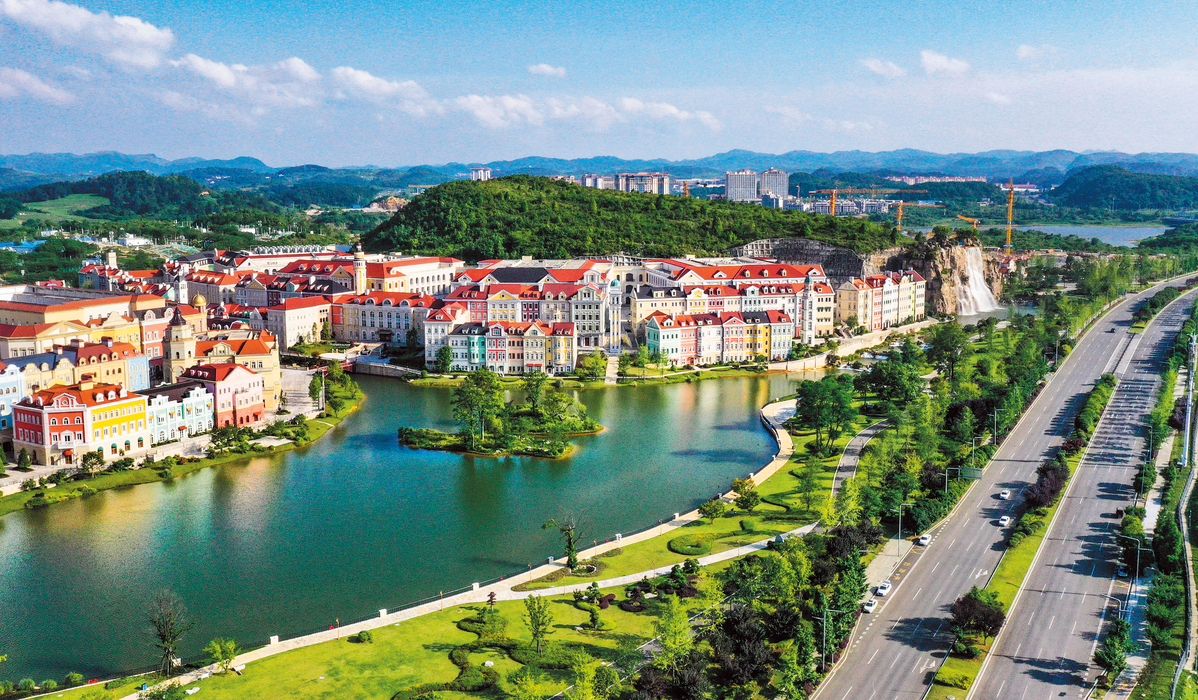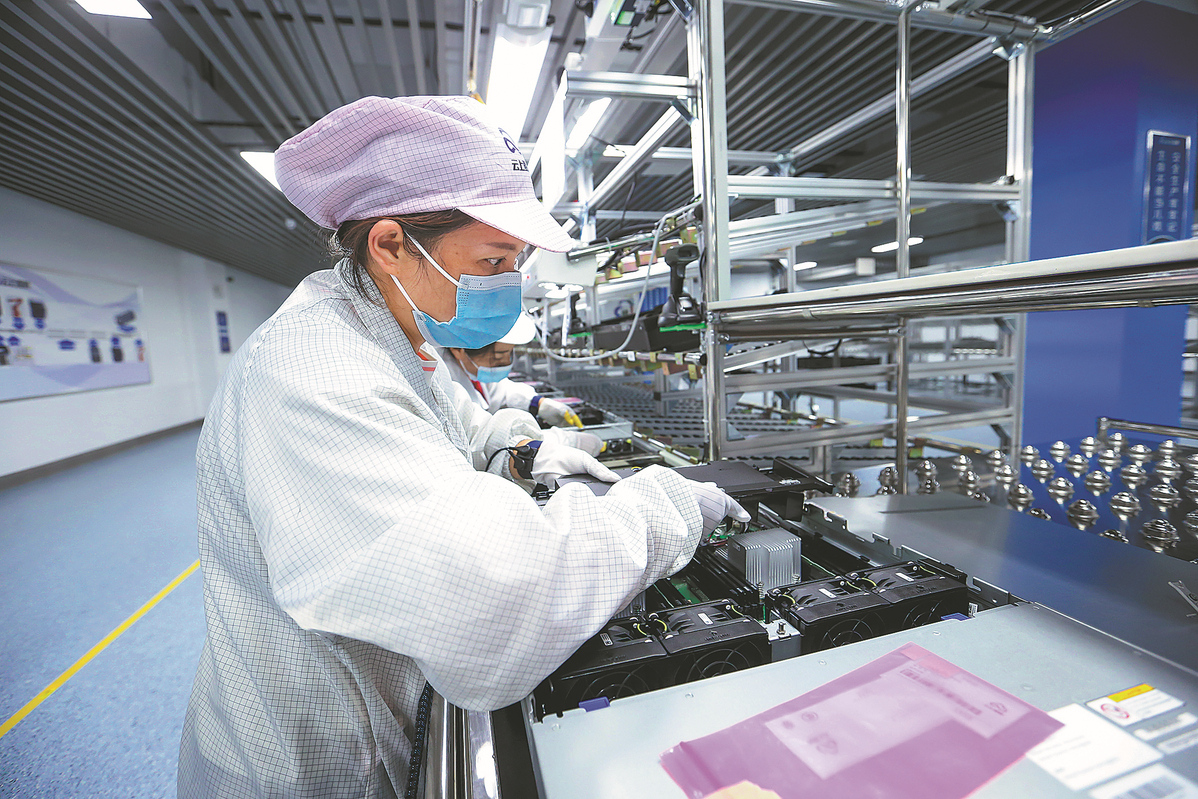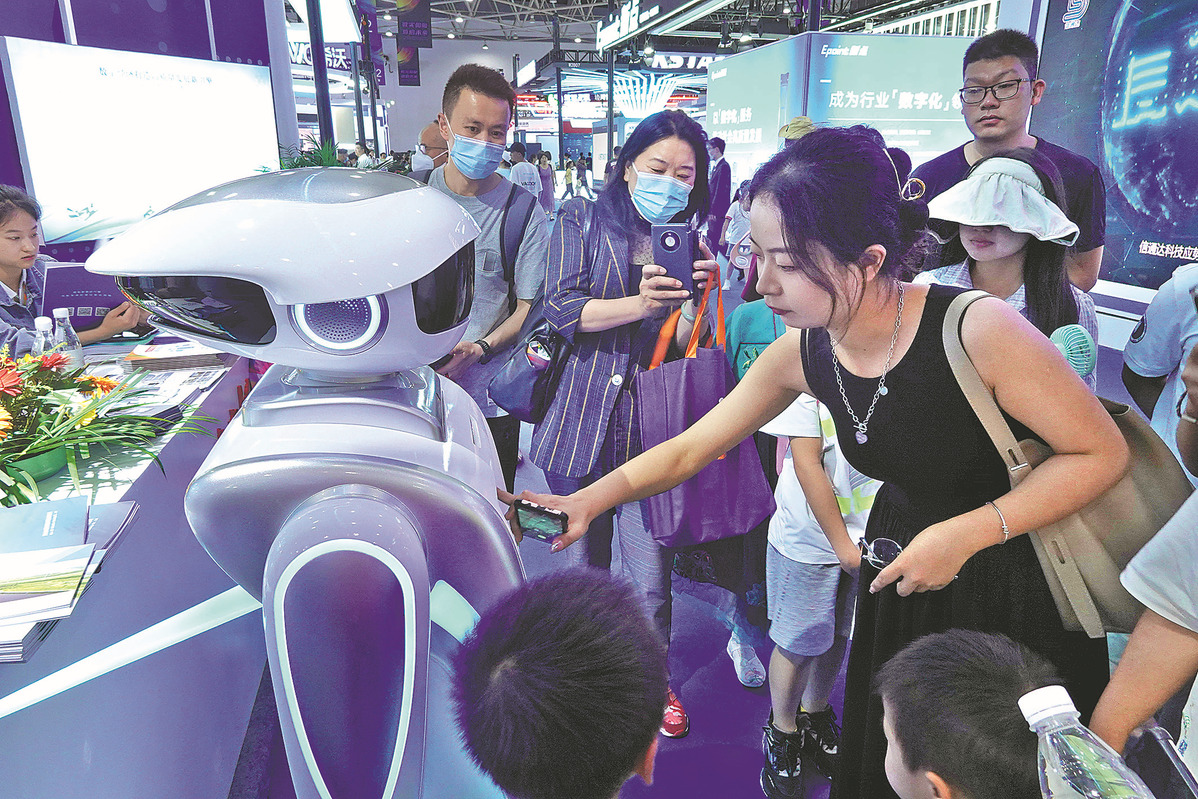Development of Digital Economy Accelerating as Data Cluster Grows

A view of the data center built by Huawei Cloud in Gui'an New Area, near Guiyang. CHINA DAILY
Southwest China is helping to spearhead technological advance with new computing centers and increased activity. CHEN MEILING and YANG JUN report from Gui'an New Area, Guizhou.
Gui'an New Area, which boasts a giant data center cluster for China's major telecom, internet and power companies, is accelerating the development of the country's digital economy through its strong computing power, officials said.
"In recent years, the area has continuously expanded the Gui'an data center cluster, accelerated the construction of the upstream and downstream industry chains, and made efforts to promote data storage, operation and utilization, thus providing strong support for the high-quality development of the digital economy," said Wang Ceng, deputy secretary of the Party Working Committee of Gui'an New Area.
Gui'an, in the southwestern province of Guizhou, is one of 19 national-level new areas. It is playing a crucial role in implementing the country's program to build more data infrastructure across the western regions.
Launched in February last year, the program aims to guide the dense computing demand from China's eastern regions for storage and computing in the western areas. Data centers require massive amounts of land, electricity and water, and although the eastern regions are economically developed, they face great pressure in energy supply for data storage and computing.
However, the western areas have large amounts of land, lower labor costs and sufficient power, thanks to their rich energy-related resources such as coal, wind and sunlight, which makes them ideal locations for data centers. The program will encourage more companies to develop in western cities to boost local economies, experts said.
Guizhou has been named as one of eight national computing power hubs, with the Gui'an data center cluster becoming one of 10 such national clusters.
Three telecom giants — China Mobile, China Unicom and China Telecom — and tech giants Apple, Tencent and Huawei, have built data centers in Gui'an. Meanwhile, China Southern Power Grid and State Power Investment Corp are also constructing their own data centers in the new area.
So far, 21 data centers have been built, are under construction or at the planning stage in Gui'an, with planned capacity of 450,000 racks and a server scale of 4.29 million units. So far, 645,000 servers have been powered on, data from the local authorities show.

An employee works on an assembly line of Guizhou Yunshang Kunpeng Technology in Gui'an New Area. CHINA DAILY
Three reasons for success
Zhang Quan, head of the industry team of the Big Data and Technological Innovation Bureau in Gui'an New Area, said there are three reasons why the area has attracted so many leading companies.
First, the geological structure is stable. "We haven't seen an earthquake greater than magnitude 3 in many years," he said. "Data centers cannot be moved casually like factories: once they bed down, they are supposed to operate in the same place for a very long time."
The second reason is that the annual average temperature is only 15 C, so it's never too hot in summer or too cold in winter, which will save a lot of money and energy in terms of air conditioners and coolers.
"The air quality is good, so there's no need to purchase dust-removing equipment. The mountainous landscape also offers natural ventilation," Zhang said.
Third, following the construction of the data centers, upstream hardware manufacturers and downstream applications development companies have moved to the area, thus lowering costs for companies to find business partners, he added.

Attendees at the data expo in Guiyang interact with a robot on May 27. QIN GANG/FOR CHINA DAILY
Huawei Cloud has built its biggest data center in Gui'an New Area, planning to situate 1 million servers there.
Transferring data centers to Guizhou and the Inner Mongolia autonomous region offers a significant advantage, primarily because of the stable and affordable energy supply and unique climatic advantages. For example, Guizhou boasts abundant water resources that drive many hydroelectric power stations and provide ample supplies for cooling servers and generating power while significantly reducing electricity costs, the company said.
Now, the data center provides critical solutions such as large-scale enterprise cloud data migration, big data processing, cloud storage, cloud backup and cloud rendering. It mainly serves customers from high-computing and resource-consuming companies in the film and television production, automotive, home furnishings, biomedical and other industries.
Zhang added that Huawei Cloud has helped about 200 companies in Guizhou with their digital transformations by raising production efficiency, lowering the defect rate and promoting the integrated management of production and sales, thereby preventing overproduction.

Visitors attend the data expo in Guiyang on May 26. CHINA DAILY
Complete industry chain
Based on the data center cluster, Gui'an has developed an electronic information manufacturing industry as the equipment used in data centers needs to be replaced every five years. In the first half of this year, this above designated size industry — that is, one generating annual revenue of 20 million yuan ($2.7 million) or more — in Gui'an and Guiyang, the nearby provincial capital, reached total industrial output value of 9.67 billion yuan, year-on-year growth of 17 percent, according to statistics provided by the new area.
It has also developed software and information technology service industries. The revenue of the industries in Gui'an and Guiyang surpassed 37 billion yuan in the first half of the year, a rise of 16.6 percent year-on-year.
One of the applications is video rendering. The grand scene of astronauts taking the 90,000-kilometer-high elevator to the space station in the blockbuster The Wandering Earth II impressed audiences worldwide. But few people know that the special effects were achieved through the supercomputing power based in Gui'an New Area.
In the film, there are many scenes of computer-generated space infrastructure and fighter jets that required tremendous computing power to render.
"Each frame takes the Gui'an New Area Supercomputing Center seven to eight hours to render, and it requires machines to operate 24 hours a day to achieve the effects seen by the audience," said Peng Benqian, director of the technical research and development department at Gui'an New Area Science and Technology Innovation Industries Development, the company that runs the center.
The process of rendering involves taking raw video footage, audio and effects, then combining them to create a finished video file. It requires powerful computer hardware and software, especially for complex projects or high-resolution videos.
It would take several years for an ordinary computer to renter a 3D animated film, but it only takes three months at the center, Peng said.
The company has participated in rendering about 50 films, TV series and animations, including Three-Body, The Battle at Lake Changjin and Boonie Bears: Guardian Code, contributing to a total box-office figure of 6.38 billion yuan.

A tech engineer checks the status of computing devices at a cloud data center owned by China Telecom in Gui'an New Area on May 23. TAO LIANG/FOR CHINA DAILY
More than 600 servers operate 24 hours a day at the center, nicknamed Guizhou's Super Brain. It also cooperates with universities and companies to research astronomy, gene sequencing and calculations that make buildings less vulnerable to earthquake damage.
Wang said the new area will focus on computing power, empowerment and industry, and strive to build three dominant industrial clusters: data centers; intelligent terminals; and data applications.
"We will make every effort to develop the leading industry of 'cloud services' and accelerate the construction of a digital economic development and innovation zone," he said.
The area has invested in improving the network infrastructure to make it faster and more efficient, thus reducing the delay, or latency, in transferring data between different locations.
It has established direct connections with 38 cities including Shanghai, Guangzhou and Shenzhen (both in Guangdong province), achieving latency of 3 milliseconds within the province.
The latency to the Chengdu-Chongqing region and surrounding provinces is 6 ms, to Guangdong-Hong Kong-Macao area it is 10 ms, to the Yangtze River Delta it is 15 ms, and to the Beijing-Tianjin-Hebei region it is 20 ms, all of which meet the low latency requirements of most businesses, according to local authorities.